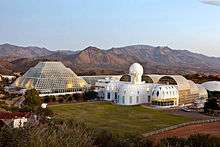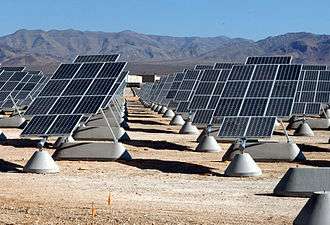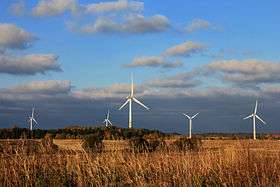Technogaianism
| Part of the Ideology series on |
| Transhumanism |
|---|
 |
| Overviews |
| Currents |
| Politics |
| Organizations |
|
|
Technogaianism (a portmanteau word combining "techno-" for technology and "gaian" for Gaia philosophy) is a bright green environmentalist stance of active support for the research, development and use of emerging and future technologies to help restore Earth's environment. Technogaians argue that developing safe, clean, alternative technology should be an important goal of environmentalists.[1]
Philosophy
This point of view is different from the default position of radical environmentalists and a common opinion that all technology necessarily degrades the environment, and that environmental restoration can therefore occur only with reduced reliance on technology. Technogaians argue that technology gets cleaner and more efficient with time. They would also point to such things as hydrogen fuel cells to demonstrate that developments do not have to come at the environment's expense. More directly, they argue that such things as nanotechnology and biotechnology can directly reverse environmental degradation. Molecular nanotechnology, for example, could convert garbage in landfills into useful materials and products, while biotechnology could lead to novel microbes that devour hazardous waste.[1]
While many environmentalists still contend that most technology is detrimental to the environment, technogaians point out that it has been in humanity's best interests to exploit the environment mercilessly until fairly recently. This sort of behaviour follows accurately to current understandings of evolutionary systems, in that when new factors (such as foreign species or mutant subspecies) are introduced into an ecosystem, they tend to maximise their own resource consumption until either, a) they reach an equilibrium beyond which they cannot continue unmitigated growth, or b) they become extinct. In these models, it is completely impossible for such a factor to totally destroy its host environment, though they may precipitate major ecological transformation before their ultimate eradication. Technogaians believe humanity has currently reached just such a threshold, and that the only way for human civilization to continue advancing is to accept the tenets of technogaianism and limit future exploitive exhaustion of natural resources and minimize further unsustainable development or face the widespread, ongoing mass extinction of species.[2] Furthermore, technogaians argue that only science and technology can help humanity be aware of, and possibly develop counter-measures for, risks to civilization, humans and planet Earth such as a possible impact event.[1]
Sociologist James Hughes mentions Walter Truett Anderson, author of To Govern Evolution: Further Adventures of the Political Animal, as an example of a technogaian political philosopher;[3] argues that technogaianism applied to environmental management is found in the reconciliation ecology writings such as Michael Rosenzweig's Win-Win Ecology: How The Earth's Species Can Survive In The Midst of Human Enterprise;[2] and considers Bruce Sterling's Viridian design movement to be an exemplary technogaian initiative.[1][4]
The theories of English writer Fraser Clark may be broadly categorised as technogaian. Clark advocated "balancing the hippie right brain with the techno left brain". The idea of combining technology and ecology were extrapolated at length by a South African eco-anarchist project in the 1990s. The Kagenna Magazine project aimed to combine technology, art and ecology in an emerging movement that could restore the balance between human and nature.
George Dvorsky suggests the sentiment of technogaianism is to heal the Earth, use sustainable technology, and create ecologically diverse environments.[5] Dvorsky argues that defensive counter measures could be designed to counter the harmful effects of asteroid impacts, earthquakes, and volcanic eruptions.[5] Dvorksky also suggest that genetic engineering could be used to reduce the environmental impact humans have on the earth.[5]
Methods
Environmental monitoring

Technology facilities the sampling, testing and monitoring of various environments and ecosystems. NASA uses space-based observations to conduct research on solar activity, sea level rise, the temperature of the atmosphere and the oceans, the state of the ozone layer, air pollution, and changes in sea ice and land ice.[6]
Geoengineering
Climate engineering is a technogaian method that uses two categories of technologies- carbon dioxide removal and solar radiation management. Carbon dioxide removal addresses a cause of climate change by removing one of the greenhouse gases from the atmosphere. Solar radiation management attempts to offset effects of greenhouse gases by causing the Earth to absorb less solar radiation.
Earthquake engineering is a technogaian method concerned with protecting society and the natural and man-made environment from earthquakes by limiting the seismic risk to acceptable levels.[7] Another example of a technogaian practice is an artificial closed ecological system used to test if and how people could live and work in a closed biosphere, while carrying out scientific experiments. It is in some cases used to explore the possible use of closed biospheres in space colonization, and also allows the study and manipulation of a biosphere without harming Earth's.[8] The most advanced technogaian proposal is the "terraforming" of a planet, moon, or other body by deliberately modifying its atmosphere, temperature, or ecology to be similar to those of Earth in order to make it habitable by humans.[9]
Genetic engineering
S. Matthew Liao, professor of philosophy and bioethics at New York University, claims that the human impact on the environment could be reduced by genetically engineering humans to have, a smaller stature, an intolerance to eating meat, and an increased ability to see in the dark, thereby using less lighting.[10] Liao argues that human engineering is less risky than geoengineering.[11]
Genetically modified foods have reduced the amount of herbicide and insecticide needed for cultivation. The development of glyphosate-resistant (Roundup Ready) plants has changed the herbicide use profile away from more environmentally persistent herbicides with higher toxicity, such as atrazine, metribuzin and alachlor, and reduced the volume and danger of herbicide runoff.[12]
An environmental benefit of Bt-cotton and maize is reduced use of chemical insecticides.[13][14] A PG Economics study concluded that global pesticide use was reduced by 286,000 tons in 2006, decreasing the environmental impact of herbicides and pesticides by 15%.[15] A survey of small Indian farms between 2002 and 2008 concluded that Bt cotton adoption had led to higher yields and lower pesticide use.[16] Another study concluded insecticide use on cotton and corn during the years 1996 to 2005 fell by 35,600,000 kilograms (78,500,000 lb) of active ingredient, which is roughly equal to the annual amount applied in the EU.[17] A Bt cotton study in six northern Chinese provinces from 1990 to 2010 concluded that it halved the use of pesticides and doubled the level of ladybirds, lacewings and spiders and extended environmental benefits to neighbouring crops of maize, peanuts and soybeans.[18][19]
| Examples of Technogaianism | ||||||||||||||||||
|---|---|---|---|---|---|---|---|---|---|---|---|---|---|---|---|---|---|---|
|
Related environmental ethical schools and movements
See also
References
- 1 2 3 4 Hughes, James (2004). Citizen Cyborg: Why Democratic Societies Must Respond to the Redesigned Human of the Future. Westview Press. ISBN 0-8133-4198-1.
- 1 2 Rosenzweig, Michael (2005). Win-Win Ecology: How The Earth's Species Can Survive In The Midst of Human Enterprise. Clarendon Press. ISBN 0-19-515604-8.
- ↑ Anderson, Walter Truett (1987). To Govern Evolution: Further Adventures of the Political Animal. Harcourt. ISBN 0-15-190483-9.
- ↑ Sterling, Bruce (2001). "Viridian: The Manifesto of January 3, 2000". Retrieved 2007-01-28.
- 1 2 3 George Dvorsky, 7 Best-Case Scenarios for the Future of Humanity, Sentient Developments, (Feb. 2, 2013).
- ↑ Global Climate Change: Vital Signs of the Planet: NASA's Role, Taking a global perspective on Earth's climate
- ↑ Bozorgnia, Yousef; Bertero, Vitelmo V. (2004). Earthquake Engineering: From Engineering Seismology to Performance-Based Engineering. CRC Press. ISBN 978-0-8493-1439-1.
- ↑ Gitelson, I. I.; Lisovsky, G. M. & MacElroy, R. D. (2003). Manmade Closed Ecological Systems. Taylor & Francis. ISBN 0-415-29998-5.
- ↑ Zubrin, Robert, The Case for Mars: The Plan to Settle the Red Planet and Why We Must, pp. 248-249, Simon & Schuster/Touchstone, 1996, ISBN 0-684-83550-9
- ↑ Ross Anderson, How Engineering the Human Body Could Combat Climate Change, The Atlantic, (March 12, 2012).
- ↑ S. Mathew Liao, Human Engineering and Climate Change, (Feb. 12, 2012).
- ↑ Shipitalo MJ, Malone RW, Owens LB (2008). "Impact of Glyphosate-Tolerant Soybean and Glufosinate-Tolerant Corn Production on Herbicide Losses in Surface Runoff". Journal of Environment Quality. 37 (2): 401–8. doi:10.2134/jeq2006.0540. PMID 18268303.
- ↑ Roh JY, Choi JY, Li MS, Jin BR, Je YH (April 2007). "Bacillus thuringiensis as a specific, safe, and effective tool for insect pest control". J. Microbiol. Biotechnol. 17 (4): 547–59. PMID 18051264.
- ↑ Marvier M, McCreedy C, Regetz J, Kareiva P (June 2007). "A meta-analysis of effects of Bt cotton and maize on nontarget invertebrates". Science. 316 (5830): 1475–7. doi:10.1126/science.1139208. PMID 17556584.
- ↑ Brookes, Graham & Barfoot, Peter (2008) Global Impact of Biotech Crops: Socio-Economic and Environmental Effects, 1996-2006 AgBioForum, Volume 11, Number 1, Article 3. Retrieved 12 August 2010
- ↑ Krishna, Vijesh V.; Qaim, Matin (2012). "Bt cotton and sustainability of pesticide reductions in India". Agricultural Systems. 107: 47–55. doi:10.1016/j.agsy.2011.11.005.
- ↑ Kovach J, Petzoldt C, Degni J, Tette J. "A Method to Measure the Environmental Impact of Pesticides". New York State Agricultural Experiment Station. Retrieved 23 November 2008.
- ↑ Carrington, Damien (13 June 2012) GM crops good for environment, study finds The Guardian. Retrieved 16 June 2012
- ↑ Lu, Yanhui; Wu, Kongming; Jiang, Yuying; Guo, Yuyuan; Desneux, Nicolas (2012). "Widespread adoption of Bt cotton and insecticide decrease promotes biocontrol services". Nature. 487 (7407): 362–5. doi:10.1038/nature11153. PMID 22722864.
- ↑ Jan Suszkiw (November 1999). "Tifton, Georgia: A Peanut Pest Showdown". Agricultural Research magazine. Archived from the original on 12 October 2008. Retrieved 2008-11-23.








.jpg)